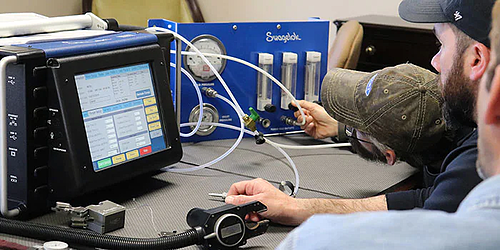Share this
Orbital Welding Training for Tube-to-Tube Applications in Northern California
by Jason Burns on 9/23/22 9:00 AM

Orbital welding provides significant benefits for welding tube-to-tube applications. By using programmable power supplies, a trained orbital welder will have precise control of the welding pattern, providing both cosmetic and structural benefits. Orbital welding provides a high level of efficiency, as well as consistent and repeatable welds while avoiding welder fatigue—a common problem for manual welding that increases human error when working long hours and when many welds are required.
All of these benefits of orbital welding are achievable when your personnel is properly trained. After receiving comprehensive training from our orbital welding experts, your welders will be able to program the Swagelok orbital welding power supplies, adjust the weld programs for changes in weld bead appearance, account for different materials and wall thicknesses, and create a repeatable weld program to increase welding efficiency.
Here, we discuss the benefits of orbital welding for tube-to-tube applications, the training necessary for orbital welding for tube-to-tube applications, and suggest a pathway to gain orbital welding capabilities at a manufacturing or maintenance facility.
The Benefits of Orbital Welding for Tube-to-Tube Applications
Orbital welding can provide many benefits for tube-to-tube applications. These benefits include improved quality, increased reliability, better efficiency, and cost savings.
- Improved Quality of Welds: Because orbital welding is automated by machine welding, human error and issues from welder fatigue are reduced. In addition, the precise control provided by orbital welding allows for consistent and repeatable welds.
- Increased Reliability: Orbital welding allows for quick adjustments to the weld program. The ability to quickly adjust welding traits combined with accurate instrument readings, results in high-quality welds.
- Ease of Welding: With a well-trained operator and high-quality equipment, orbital welding can be used to provide a means to weld complex designs with a large number of joints.
- Highly Efficient Welding: With orbital welding, the characteristics of the weld can be programmed. Once programmed, exact welds can be duplicated with ease.
- Real-Time Data for Ongoing Welding: Orbital welding utilizes sensors to transmit real-time data on the weld. This data can be used to determine issues during welding and quickly adjust the programmed welding characteristics.
- Remote Control: Orbital welding machines can be controlled remotely. This allows for flexibility in the location of personnel operating orbital welding.
- Financial Returns: Through increased quality and reliability of welds, orbital welding will decrease product defects and time and resources spent on welding.
The benefits of orbital welding for tube-to-tube applications are significant. To gain these benefits, personnel need to be properly trained. This training needs to be comprehensive and cover the common issues that orbital welders are likely to face.
Orbital Welding Training for Tube-to-Tube Applications
Comprehensive orbital weld training for tube-to-tube applications must cover several key concepts. These concepts in orbital welding will allow personnel to conduct orbital welding on a wide range of applications. The following should be covered by an orbital welding training program:
Basic Welding Principles
An orbital welding course will cover basic welding principles including how welding works to fuse two parts together. It will discuss how temperature, gas flow and pressure are used during welding as well as the different type of joints that are welded.
Orbital Welding Programming
A training course in orbital welding will go over how to program the power supply for orbital welding. This programming must take into account the basic variables of the weld, such as material, outside diameter of the components, wall thicknesses, and joint types like tube-to-tube or pipe-to-pipe.
Setting Up Orbital Welding Machinery
A training course will discuss how best to position the orbital welding machinery and the components to undergo orbital welding. This set-up will allow for the repeatability of welds as well as help to meet Cal/OSHA guidelines.
Material Variation
Different materials require different programs for welding. These materials include many types of metals, like Stainless Steel, Hastelloy, or Inconel. A comprehensive training course will go over how to adjust orbital welding programs based on the material used.
Replicating Welds
Many times, a weld will need to be done several times to the exact same specifications. Though this is common in many manufacturing facilities where the same item is repeatably created, it is also common in other types of facilities where similar repairs are frequently needed. Through proper training, operators will learn how to save their programmed orbital welding information to replicate welds in the future. In addition, they will learn how to adjust their previous programmed welding information for different materials.
Troubleshooting Common Problems
Training programs should also discuss how to troubleshoot common issues with orbital welding including programming errors, improper setup, and weld misalignment.
Prepare for ASME Section IX Qualifications
Orbital welding training should also prepare welders for ASME section IX qualifications. This qualifies welders to weld based on a range of wall thicknesses and outer diameters. Swagelok’s orbital welding training covers ¼ in-2 in (6mm-50mm) thickness.
Welding According to AWS Safety Recommendations
In addition to techniques for reliability and efficiency, thorough orbital welding training should also ensure trainees understand how to abide by safety standards as recommended by the American Welding Society (AWS).
Comprehensive training to develop advanced orbital welding skills can help your employees achieve weld consistency and reliability, and return to work ready to apply these skills. However, the real challenge is to find the right partner to meet training goals with ease.
Let Swagelok Prepare Your Team for Reliable Orbital Welding
Swagelok is a trusted manufacturer, known for producing premium, high-quality welding tools. Swagelok offers a five-day, comprehensive GTAW orbital welding training program to help new and experienced welders achieve acceptable orbital welds with Swagelok welding systems. The program includes both classroom training and hands-on experience.
The course is run by veteran instructors qualified at an Inspector (CWI) or an Educator (CWE) level with industry expertise of more than five years. They combine traditional classroom teachings with hands-on field experiences to help trainees clear fundamental gaps with ease. The program also offers training to guide your operators long after the training ends. Our training program helps save time and resources and achieve improved employee morale at the same time. With customized course content and certified experienced instructors, your employees get to know all critical aspects of orbital welding that skilled welders learn from years of experience.
By the end of the program, trainees are able to understand the setup and operation of Swagelok’s M200 Orbital Welding System. They are also able to prepare weld samples to test for ASME Section IX Qualification. Finally, welders must pass two exams before they can earn a certificate of completion.
To find out more about how Swagelok Northern California can help you with orbital welding training for tube-to-tube applications, contact our team today by calling 510-933-6200.
 About Jason Burns| Technical Services Manager
About Jason Burns| Technical Services Manager
Known to customers and Swagelok Northern California associates as the Swagelok Answer Man. Jason spends his work days answering customers' technical questions about Swagelok products and tools and training customers how to install and use them.
Share this
- Archive (465)
- Assembly Services (207)
- About (100)
- Seal Support Systems (96)
- Best Practices (88)
- Training Services (74)
- Fittings (51)
- Semiconductor Applications (49)
- Hoses and Flexible Tubing (47)
- Regulators (44)
- Tubing (42)
- Grab Sampling Systems (32)
- Sampling Systems (32)
- Gas Systems (30)
- Services (30)
- Downloads (29)
- Valves (24)
- Application Support (18)
- Orbital Welding (17)
- Case Studies (13)
- Steam Systems (13)
- Frequently Asked Questions (12)
- Tools (12)
- Measurement Devices (7)
- Subsystems (6)
- Thermal Management (6)
- September 2023 (1)
- August 2023 (2)
- June 2023 (1)
- March 2023 (3)
- February 2023 (3)
- January 2023 (4)
- December 2022 (4)
- November 2022 (4)
- October 2022 (4)
- September 2022 (1)
- August 2022 (3)
- July 2022 (2)
- June 2022 (4)
- May 2022 (1)
- April 2022 (2)
- March 2022 (1)
- February 2022 (2)
- January 2022 (3)
- December 2021 (1)
- November 2021 (6)
- October 2021 (6)
- September 2021 (8)
- August 2021 (4)
- July 2021 (3)
- June 2021 (6)
- May 2021 (6)
- April 2021 (7)
- March 2021 (5)
- February 2021 (4)
- January 2021 (6)
- December 2020 (5)
- November 2020 (6)
- October 2020 (6)
- September 2020 (8)
- August 2020 (7)
- July 2020 (8)
- June 2020 (8)
- May 2020 (6)
- April 2020 (9)
- March 2020 (7)
- February 2020 (10)
- January 2020 (21)
- December 2019 (23)
- November 2019 (21)
- October 2019 (22)
- September 2019 (21)
- August 2019 (22)
- July 2019 (23)
- June 2019 (20)
- May 2019 (23)
- April 2019 (22)
- March 2019 (21)
- February 2019 (20)
- January 2019 (21)
- December 2018 (14)
- November 2018 (19)
- October 2018 (23)
- September 2018 (17)
- August 2018 (29)
- July 2018 (11)
- June 2018 (6)
- May 2018 (5)
- April 2018 (4)
- March 2018 (5)
- February 2018 (3)
- January 2018 (3)
- December 2017 (2)
- November 2017 (4)
- October 2017 (3)
- September 2017 (2)
- August 2017 (6)
- July 2017 (4)
- June 2017 (4)
- May 2017 (4)
- April 2017 (3)
- March 2017 (4)
- February 2017 (3)
- January 2017 (3)
- December 2016 (3)
- November 2016 (3)
- October 2016 (3)
- September 2016 (5)
- August 2016 (5)
- July 2016 (4)
- June 2016 (5)
- May 2016 (3)
- April 2016 (4)
- March 2016 (5)
- February 2016 (11)
- January 2016 (1)
- December 2015 (3)
- November 2015 (4)
- October 2015 (3)
- September 2015 (4)
- August 2015 (4)
- July 2015 (8)
- June 2015 (5)
- May 2015 (3)
- April 2015 (4)
- March 2015 (4)
- February 2015 (3)
- January 2015 (4)
- December 2014 (2)
- November 2014 (3)
- October 2014 (4)
- September 2014 (4)
- August 2014 (4)
- July 2014 (5)
- June 2014 (4)
- May 2014 (4)
- April 2014 (5)
- March 2014 (4)
- February 2014 (3)
- January 2014 (4)
- December 2013 (5)
- November 2013 (3)
- October 2013 (4)
- September 2013 (3)
- August 2013 (5)
- July 2013 (5)
- June 2013 (5)
- May 2013 (3)
- April 2013 (6)
- March 2013 (4)
- February 2013 (4)
- January 2013 (8)
- December 2012 (4)
- November 2012 (6)
- October 2012 (6)
- September 2012 (4)
- August 2012 (4)
- July 2012 (4)
- June 2012 (4)

.webp?width=210&height=70&name=StickyLogo%20(5).webp)